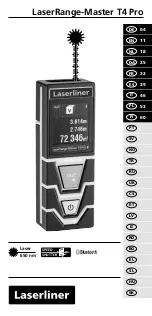
SensyMaster FMT230, FMT250
THERMAL MASS FLOWMETER | OI/FMT230/250-EN REV. C
65
Application of the Health Indication Registers
(Condensed Status Registers)
)
The OI_FMT230_250_EN_C has three ‘Health indication registers’
(Condensed Status Registers). The ‘Health indication register
2104, 2105 and 2106 consist of 2 bytes, each containing 8 bits.
Each bit represents an error.
The registers are structured as follows:
Figure 54: Health indication register (example)
The bit position is assigned to the errors in accordance with
column ‘Byte / Bit pos.’ of the table in
Alarm status and alarm
history status
on page 96.
The following assignment applies to the example in Figure 54:
Byte / Bit
Fault message
Byte 0 / Bit 3
Flowrate to zero
Byte 0 / Bit 5
All totalizer stopp.
Byte 4 / Bit 5
Medium temperat exceeds limits.
Using the scan register
The SensyMaster FMT230, FMT250 has two ‘Scan Register’ via
which groups of parameters can be requested.
As a result, the parameters do not need to be requested
individually and the bus load on the Modbus is reduced.
A scan register consists of a configuration register and the
actual scan register.
Configuration register
The Modbus addresses of the parameters are entered in the
configuration register. These addresses are to be requested as a
group when the scan register is read. The configuration is stored
in the transmitter and must only be rewritten in the event of
changes. A maximum of 32 Modbus addresses may be stored.
Scan Register
When read out, the Scan Register returns the values of the
parameters that were entered in the configuration register.
The scan register has a length of 32 holding registers that must
be considered when entering addresses in the configuration
register.
For example, a maximum of 32 addresses with a register length
of [1] can be requested via the scan register.
Note
If the total register length of the addresses entered in the
configuration register exceeds the register length of the scan
register, the response will be shortened accordingly when read
out.
Restrictions
When using the Scan Registers, observe the following points:
• The scan registers are read only. It is not possible to gain
write access to the parameters entered in the configuration
register.
• Action Registers cannot be addressed via the Scan Registers,
as Action Registers require write access
• String Registers cannot be read out via the Scan Registers, as
a String would overwrite the available register length of the
Scan Register in most cases.
















































